Imagine a world in which Wordle falls in love with Crossword, who has an affair with Sudoku on the side — what kind of chaos would it beget in the game world? You do not have to ponder over it, because such a nightmare already exists, thankfully. Meet Crosswordle, the demon spawn with deviant DNA that will haunt you in your sleep.
And today we are going to dissect it to bones and marrow to unravel the mysterious mechanisms that dictate its game rules.
What is Crosswordle?
Crosswordle is a riff on Wordle created by Reddit user, ymichael along with his wife, by applying reverse principles on the original game. Even though it evokes sentiments akin to the Wordle game by mirroring the acknowledged color indicators (green, yellow, and grey), and a similar checkered grid Crosswordle is a variant that deconstructs the original to create a Sudoku-esque grid that traps the players in a tangled web of invalid words.
Not wordle, just another word game 🙃https://t.co/vJ4ply9fly pic.twitter.com/INNZbqDzYP
— Crosswordle (@playcrosswordle) January 30, 2022
It is hosted as a free game for players at crosswordle.vercel.app and can be played on any web browser on both PC/Desktop or smart devices. The link opens the “daily puzzle” by default; you even get the option to play unlimited on the various difficulty-based modes. In every scenario what greets you is a grid that appears partially solved but mostly unfinished, only the number of rows varies in relation to the challenge mode.

Even though there is no time limit (apart from the familiar resetting rules of daily challenges), you will see a running timer that keeps track of the time spent on the challenge; this unobtrusively reveals that the goal of the challenge is to complete the puzzle in the shortest time frame… so, no pressure, really. Nope.
Scratching your head in confusion? Worry not, there is a definite order to the craziness of how things are designed in Crosswordle.
Related: Wordle: 5-Letter Words 3 and 4 Vowels
Where to play Crosswordle?
The game of Crosswordle is available for playing online at their official website, crosswordle.vercel.app. Crosswordle is not available as an app on the app stores, including Google Play Store and Apple App Store on Android and iPhone respectively.
- Play Crosswordle here: crosswordle.vercel.app
Crosswordle Rules Explained
Before we jump into a detailed analysis of its idiosyncrasies, let’s review the fundamentals of the game.
The “solved row”
The green, yellow, and grey tiles on Crosswordle carry the same meaning as they do in the Wordle universe, i.e, they indicate the appearance, occurrence, and frequency of the letters in the game.
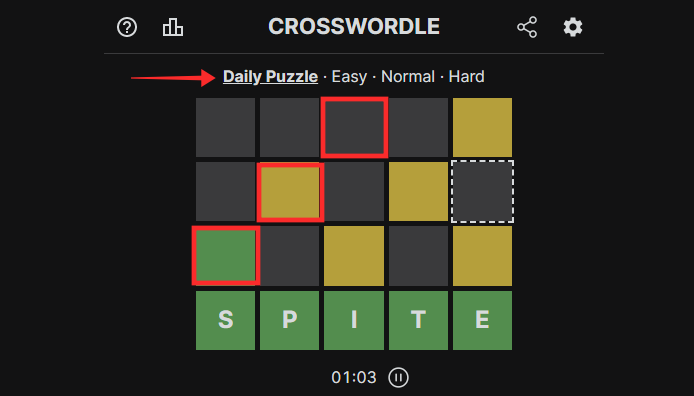
Every challenge opens to reveal the final row in a “completely solved” state — the five-letter word that already has one row completely solved (all green). There are also a few stray green and yellow tiles that are blank in essence.
The “solved row” and the blank “colored tiles” are the only hints given to the player throughout the game. Crosswordle is like a maze that you can unlock with the available keys (“green letters”).
At the same time, there is a discreet parallel formula hiding in plain sight here — the scattered “colored tiles” that you see, they aren’t casually placed there — you are mandated to use only the “green letters” that are available at the beginning of the game in these yellow/green tiles.
Now, you might think it shouldn’t be that hard to make wrong guesses to arrive at the available answer. Wait until you see the various “error” messages.
Crosswordle “Error” hints
A column when fed with an invalid or wrongly-placed letter gets highlighted with a red border that has a flag in the corner. It is accompanied by a message at the bottom of the grid expounding the nature of the error. These errors indicate that the letter (its occurrence or position) is incongruous with the game rules.
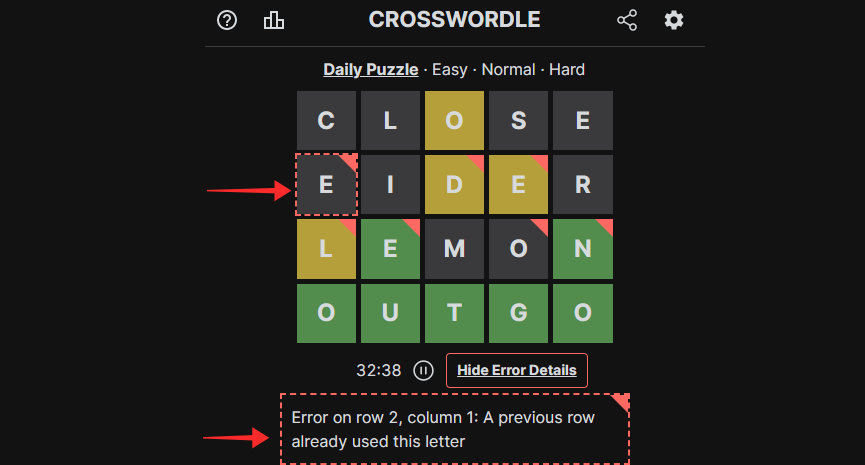
To put it simply, in the Crosswordle (daily puzzle) 4×5 grid:
- there exist “5” compulsory “green letters” in the “solution row”.
- The available “green letters” should be appropriately input in the green and yellow boxes in the “guess rows”.
- The “grey letters” can not be repeated in independent rows.
We will explore the intricacies of these rules in detail shortly.
Related: 27 Types of Wordle Variants
Crosswordle Gameplay: How does Crosswordle work
SPOILER ALERT! The following sections use the Crosswordle Daily Puzzle from February 10, 2022, to demonstrate the rules of the game. The complete puzzle may be revealed at various points to explain various errors, solutions, and rules).
To cross the jagged roads of Crosswordle, you only need to focus on one goal — it is to plan your backtracking moves from a Wordle that is in a solved state. In other words, in Crosswordle you play Wordle in reverse order, where you envision the “guesses” you supposedly made to find the mystery word of the day (which is the all-green five-letter word in the final row.)
It doesn’t sound so difficult? Think again, because there are some roadblocks you must sidestep to make your way through the game. The challenge is to orient your guesses entirely on the blank-colored tiles in the grid as any random guess would not be accepted by the system.
Let’s play the daily puzzle from February 10, 2022 to see how things work in Crosswordle.
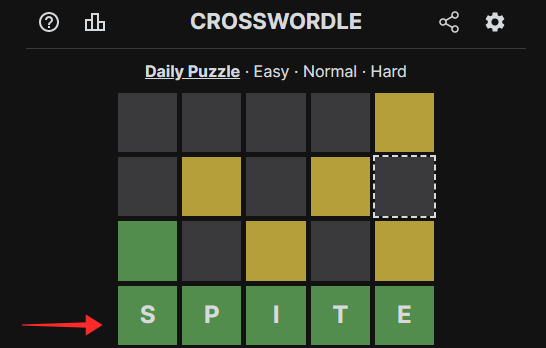
When you begin the challenge, you are already provided with the “Wordle Answer” in the solution row (as seen in the screenshot above). All the remaining tiles are blank and open for you to make your guesses. You can select any tile upon click or touch (depending on the device you play on). The selected tile gets a dotted boundary as a highlight; you can also delete any letter you input using the delete key or button.
Pro Tip: The keyboard and mouse make playing Crosswordle an inexplicably easier experience on PC. You can maneuver between tiles in all directions using the arrow keys swiftly which also allows you to make quick moves to delete or swap letters to rectify any error flags).
Related: Taylordle Archive: How to Play Old Taylordle Games
How to make your moves in Crosswordle
Now, onto making your moves — the blank tiles should be treated according to their color. In a green tile, you can only repeat the corresponding “green letter” from the solution row.
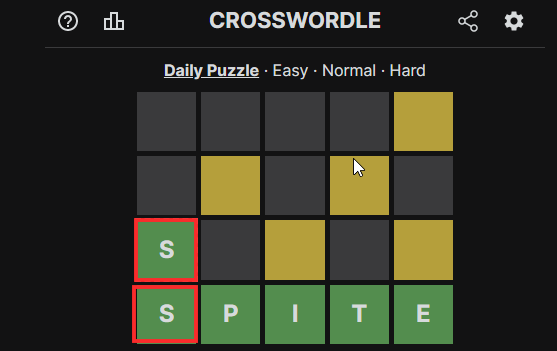
For example, in the puzzle under discussion, the only “letter” that will be accepted in the blank green tile is the “S” that is already available. If you enter any other letter, it contradicts the solution word and hence gets ousted with an error message informing you of the issue.
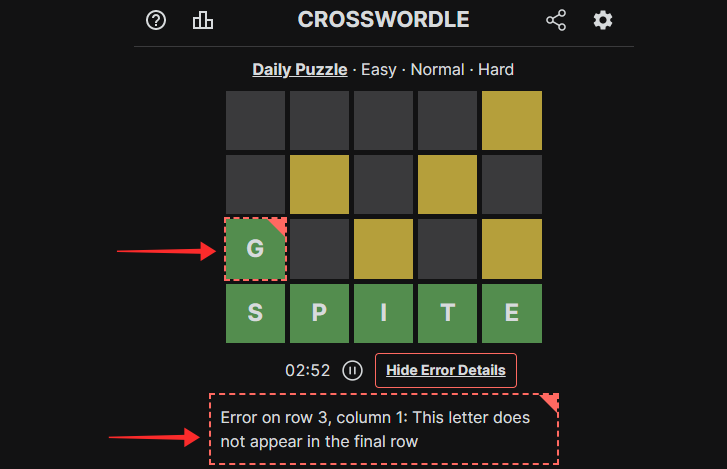
In the remaining 4 blank tiles, you must apply the same rules — that is, in the “grey tiles” you may enter any of the unused/non-compulsory letters, and in the “yellow tiles” you must enter any of the “green letters” from the final row but in the wrong position to emulate a wrong guess as we see on Wordle.
Now, there is another rule that can not be compromised at all, which is the validity of the word. Every guess word you make should not only comprise of the mandatory and nonmandatory letters, these letters should also form a real word. In case you enter a nonexistent word, you will be slapped with 5 error flags that cry “invalid word”.
To understand this rule, let’s take a look at an accepted guess in the row under discussion. In the screenshot, it can be seen that the word entered by the player is valid — it entails the correct green “S” in the blank green tile; the yellow tiles are occupied by “green” letters from the last row but in the wrong position, and the grey tiles contain letters that are newly introduced by the player (which do not occur in the solution word/final row.)

How to choose your start words
To play Crosswordle, you only need one strategy — imbibe the location of the “blank colored tiles”, observe the available “green letters” and isolate those letters which have the potential to be suitably introduced in the blank yellow and green tiles.
The “green letters” you choose to use in the guessed words play a capital role in sealing your game’s fate. If you zero in on those letters which occur rarely in the positions taken by the colored tiles, it is only an indicator of a doomed round which you will have to redo.
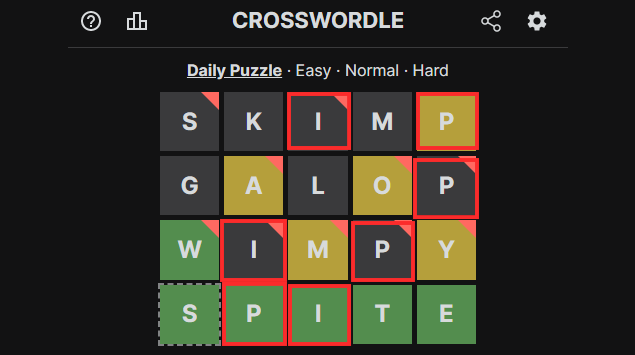
Let’s analyze it through two scenarios, one wrong and one right. In the screenshot above, we see the scenario of a hopeless puzzle. It started with the wrong letter choices made by the player. When the player chose to repeat “P” and “I” in the blank rows, the unavailability of words made of “P” and “I” in the mandated positions caused the grid to be marred with error flags of all kinds — wrong letter, wrong word, wrong position, repeated letter and what not!
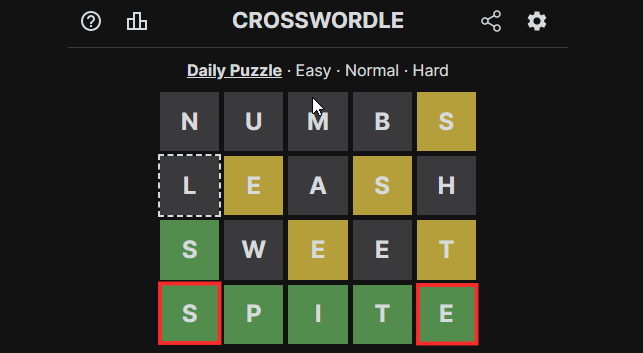
In the second scenario, we see a smarter player who has selected “S” and “E” as the letters to be repeated in the guesses. It is evident here that the rules of the game accommodate the use of common letters which frequently appear in various positions in five-letter words. The frequency of letters is a determinant factor in solving Crosswordles in the smoothest way.
The rule of thumb is to begin your solving process from the bottom up. Start from the blank row (Row 3) right above the solved green row with a priority to identify the “frequenting” letters. All the consecutive moves should be made in a similar fashion that satisfies the game rules.
However, to satisfy the game rules, you need to know what all errors get called out in the game.
How to fix red colored errors in the game
There are 7 basic errors on Crosswordle and they are broadcast to the player in a message box to cue rectifications. Let’s take a look at the “errors” and ideas to solve them.
Error #1: Letter doesn’t appear in the final row
If you input a non-occurring letter in a blank green or yellow tile, you will get an error message that reads “This letter does not appear in the final row”.

Solution: Study the final row and replace the wrong letter in the blank tile with the corresponding right letter. Example (based on the error shown in the screenshot): Replace the “G” in row 3 “green” column 1 with “S” to satisfy the condition presented by the final row.
Error #2: Letter appears in the last row
If you enter a valid “green letter” in a blank “grey tile” of any row, an error message will alert you thus — “This letter is in the final row, so it should not be in this tile”.

Solution: Example (based on the error shown in the screenshot): In Row 3, column 4, “P” is input into a green tile which goes against the given condition twice over (of “P” occurring in the final row/solution word, and P occurring in the second column in the row). To fix the column marked with error (in this case), replace the green letter with a suitable grey/non-valid letter.
Error #3: Letter appears in the same position as the last row
If you use a “valid letter” in a “blank yellow tile” that mirrors its position in the final row/solution word, you will get the error message — “In this row, this letter needs to be in a different position and should not be in the same position as it is in the final row”.
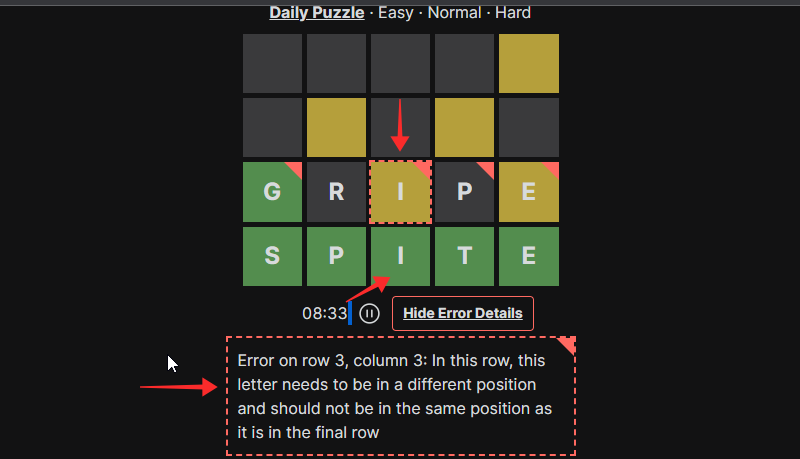
Solution: Swap the position of the letter so that it resembles a partially correct letter in Wordle that gets yellow feedback (right letter wrong position). Example (based on the error shown in the screenshot): Change the guess to a word that has “I” in the final position (if any). If there aren’t any valid words available, then your only choice is to re-pick the “green letters” to be used in the guesses.
The rule also applies to “grey letters” in hard mode — you are not allowed to assign the same position to the same letter(green or grey) on different rows.
Error #4: Letter used in a previous row.
If you repeat a non-valid “grey letter” in more than one row, it triggers the error alert — “A previous row already used this letter”.

Solution: You can repeat a valid or non-valid letter twice in the same row but not in two different rows invoking the no-repeat rule in Sudoku. Example (based on the error shown in the screenshot): Replace the repeated non-letter with an acceptable green or grey letter, i.e. change SWEAT to SWEET or replace the conflicting word with a suitable alternative.
Error #5: Non-valid words
If you enter a non-existent word as an attempt to satisfy the preconditions of the challenge, the system will reject it with the message “Invalid word in this row”.

Solution: Do not enter cooked-up words; reevaluate your letter choices if you can’t form real words with it.
Error #6: Letter used more than it occurs
If you use a green letter more than its total occurrence count in the final row, an error alert is bound to pop up that says “Too many occurrences of this letter in this row”.

Switch the position of the letter to a blank green or yellow tile to form a meaningful five-letter word. In the case of unavailability of valid words, choose a different letter like “I” or “T” from the available “green letters” to form guessed words.
Error #7: Should use letters previously found
The number of “green letters” that can be used in the guess words is directly proportional to the number of blank yellow and green tiles. If you use more “green letters” than necessary, it will contradict the hint scheme of Wordle that Crosswordle emulates and hence brings this error message — “You must use all previously found letters”.
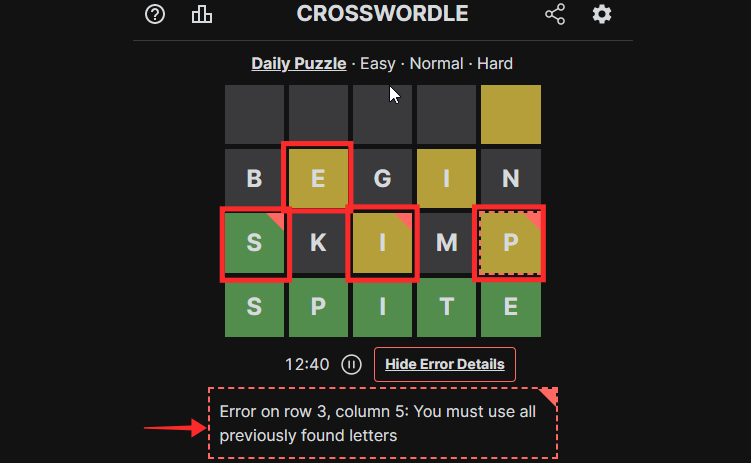
Solution: Assess the frequency of appearance of the available “green letters” to ascertain which should be carried over as a part of the guess words. This grants you a bulkier word list that helps avoid repetition or surplus.
Let’s assimilate the rules by observing the solved Crosswordle once again.

It is also to be noted that repeating a letter is legitimate if made in the same row; however, If a non-valid “grey” letter is repeated in more than one row it creates an error. There is no restriction of time or number of guesses on Crosswordle. You may enter, re-enter or delete letters or guesses as many times as it takes to form meaningful words in independent rows.
The trick is to be aware of all the letters — which “green letters” have the potential to occupy the blank “colored” tiles? How should you form words so that the grey letters don’t repeat? Constantly question each letter and its occurrence to optimize the guess.
How to share your score
So, now that we have learned to successfully conquer the monster that is Crosswordle, what is the reward? The reward is of course the pleasant and familiar score grid with a record of the duration it took you to solve it [the quicker you solve, the more brownie points you bag]. But, it doesn’t really matter even if you take hours to solve it as long you don’t give up.
The fun doesn’t have to end just there — you can even invite a friend to take on the challenge by hitting the Challenge a friend link. It could become a new daily challenge to see who scored the best time!
To share on social media, tap/click Share Game.
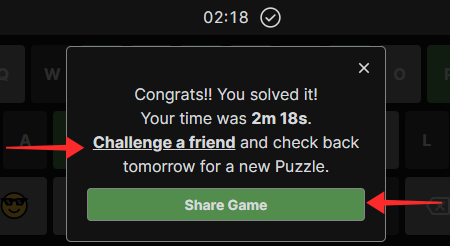
Hit Share to copy the score to the clipboard.
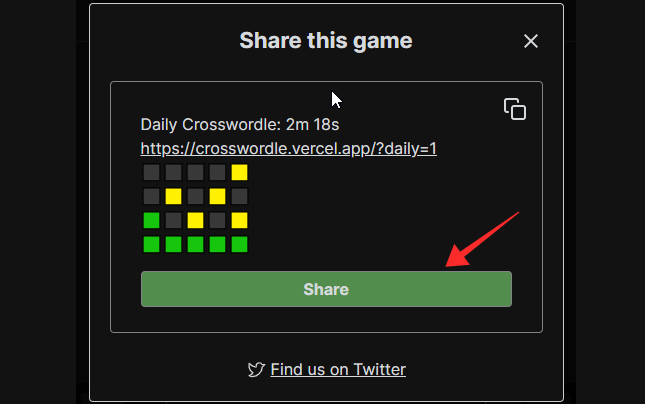
Open your favorite Social networking platform (here we have chosen Twitter web). Click on Tweet located towards the bottom left of the window to compose a new tweet.

Paste the score on the clipboard into the textbox.

You can even add any personalized message to the score data if you wish to. Just tap the text box to input the message.
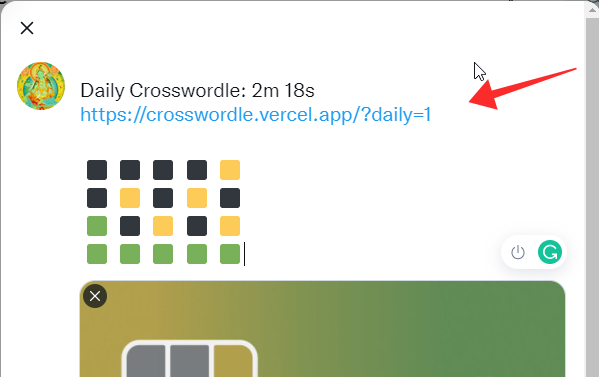
Finally, hit Tweet to send the post.

That’s it, your Crosswordle accomplishment has thus been tweeted for the world to appraise and appreciate!
What are the different modes on Crosswordle?
Crosswordle has four modes — Daily Puzzle, Easy, Normal, and Difficult. The daily puzzles run a timer to challenge the player’s speed in solving the puzzle and they reset daily to give a universal puzzle to all players. It has a 5×4 grid with unlimited guesses up for grabs.

The easy, normal, and hard modes do not have a timer keeping track of the time spent by a player on a puzzle. Similarly, any number of puzzles can be played by a player on these modes making it deliciously addictive. They are different from each other only on the basis of the size of the grid, hard being the most difficult confronting the players with an intense 6×5 grid — that is a full Wordle in reverse mode!

Normal mode (similar to Daily puzzle mode) has a 4×5 grid, which is further condensed to 3×5 in Easy mode.

Rules remain the same in all Crosswordle puzzles, your focus should be devoted to satisfying all the rules. To sidestep error alerts, you ought to plan your moves with careful calculation. You can start solving from the top row or bottom but keep an eye on the green and grey letters when you form words. A little tip, forming an alliance with a good online crossword word tool will help you come a long way in this twisted game of crosswordle-ing!
RELATED
- Wordle Answer Today: Daily Updated List
- 5-Letter Harry Potter Words List and Hints
- 10 Sweardle Words and List
- Nerdle Answer List
- Taylordle Words List
- 6 Ways to Play Old Wordle Games





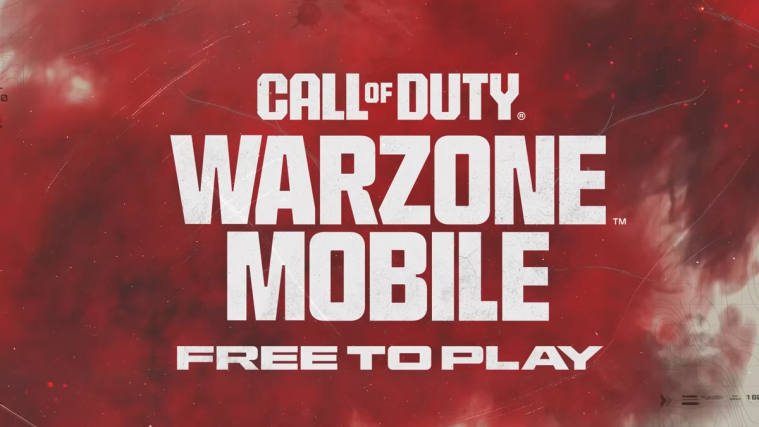
What’s the emoji on the keyboard used for in the game?